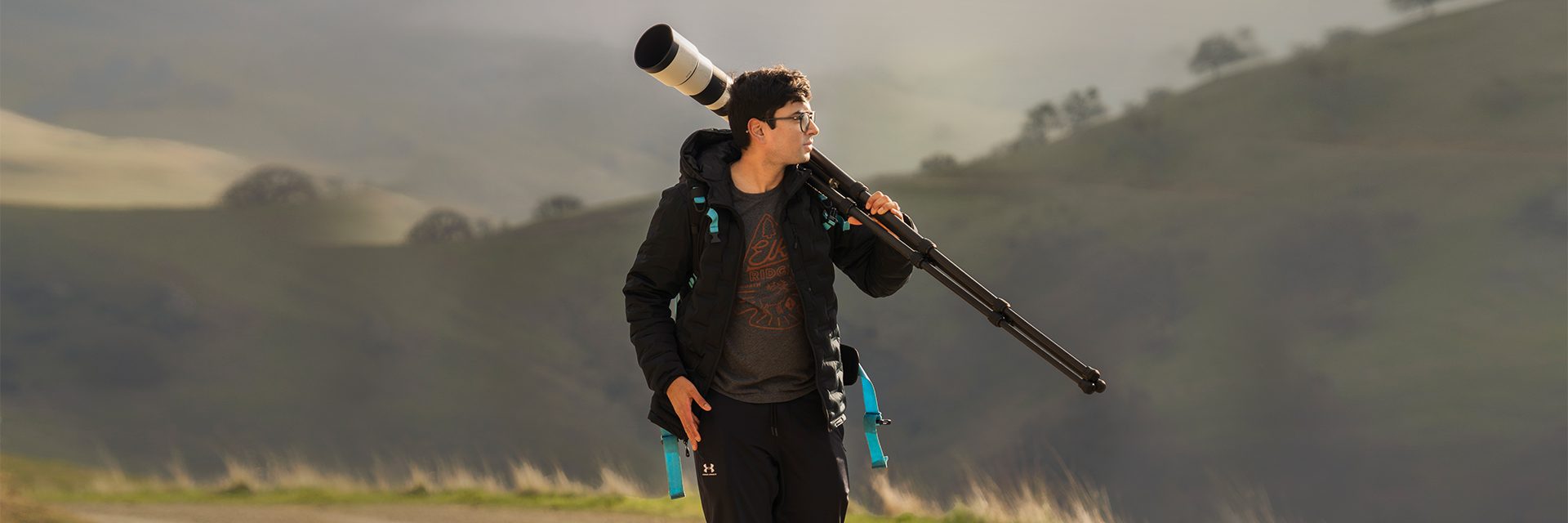(March 21, 2022) Mount Tamalpais is a popular haunt for photographers on the US West Coast, especially those who, like Tanmay Sapkal, live in the San Francisco Bay Area. The 29-year-old landscape photographer, who works as a techie at Apple by day, spends evenings driving as a shutterbug. “Mount Tamalpais is quite special as its geography lends it a lot of coastal fog. In the summertime, the fog rises above the neighbouring landscapes,” says Tanmay Sapkal, the winner of the International Landscape Photography Award 2021, in an interview with Global Indian. The Indian landscape photographer catapulted into the limelight with thousands of hits on his award-winning work of the Comet Neowise, shot in America in 2020.
It’s a shot he has taken many times over the years yet when he heard the comet was expected to make an appearance in early 2020, he knew he couldn’t miss it.

Tanmay’s photograph of Comet NeoWise glimpsed over the foggy hills in Marin, CA
How a comet created a star
Tanmay took a different approach. Instead of planning the image around the comet itself, he worked instead on finding the right foreground. “Shooting a comet is not hard. If you can shoot decently, you will capture it,” says Tanmay Sapkal. Capturing the light glowing under the blanket of fog was another story as thoroughfare is not allowed on the mountain. That evening, though, the road was open as the comet was visible. The otherworldly photograph, almost out of Arthur C Clark’s A Space Odyssey, fetched him the prestigious award. His work was chosen from over 4,500 entries. On Instagram, the photograph has now garnered over 4,000 hits, and the Best Landscape Photograph category carries a cash prize of $10,000.
The key to being a good landscape photographer, he explains, is “to know the weather.” It’s usually an interesting weather change that draws Tanmay to a spot, as “plants and trees change with seasons, as does the light.” So, if a big cloud system rolls in from the West Coast, it ascertains the location.

‘Quiet Light’ in Vermont. Photo: Tanmay Sapkal
No pain, no gain?
Braving sub-zero temperatures, venturing out at unearthly times of day and night, and spending hours on met department updates – the life of a photographer isn’t easy. Tanmay and his wife live in San Francisco (she also works for Apple). Evenings are spent, “working on images, searching for what to do next, and talking to photographers.” In summer, when the sun sets late, Tanmay takes advantage of the light, and drives off to photography locations after his work as a tech designer is done.
Seasoned landscape photographers wander off into forests for weeks on end, carrying equipment, food, water and tents, “It’s easy to go missing or to be attacked by a bear,” he says. Although, given his propensity for shuffling off into snow-covered woods, thermal shock is also a concern.

Tanmay Sapkal
His wife is his rock since his tryst with photography began in 2016, and she often accompanies him, braving the bitter cold, difficult terrain and tough spots. Work begins at twilight, which is the coldest. “It can get uncomfortable. You take your gloves off for 30 seconds and you will start to feel intense pain,” he adds.
Thermal shock in Aspen
A close call in 2018, on a trip to Aspen, Colorado shook them. His wife, an avid skier, wanted to check out the famed slopes, while Tanmay wanted to catch the riot of fall colours. A six-hour drive to Aspen, “hopped up on Redbull and coffee,” in the middle of a snowstorm, just a few hours before sunrise, with the moon overhead, Tanmay stopped for a shot. Leaving his wife sleeping, he ambled to a spot, hoping to shoot until the sun rose. “I was energetic, moving around to stay warm. But the cold tires you. After a while, I started to lose consciousness,” he recalls. He stumbled down an icy path, dizzy and in a blur, leaving his camera equipment behind in the rush. As his temperature fell rapidly, his vision worsened. Tanmay gave up the half-mile trek to the car. Luckily, although Tanmay didn’t know it, he had been spotted by a fellow photographer, who followed him. “He put I looked up at his face and I thought I saw my wife. She had come for me,” he laughs at his disorientation. The man, a photographer, volunteered to send Tanmay’s equipment back. “But hey,” Tanmay smiles, “I got a good shot that day.”

From the trip to Aspen, Colorado. Courtesy: Tanmay Sapkal
Portrait of the artist as a young man
Growing up, Tanmay and his father shared a common love for gadgets. “I would gather electronics – phones and cameras. Dad was much the same. Growing up, we had only film cameras, which were hard to shoot, and getting photos developed took ages. But it held my interest,” says the ace photographer. In ninth grade, his father bought him his first digital camera. “I would shoot everything I saw,” he recalls, though he soon forgot about it with the hustle of school.
Later, he did engineering at NIT-Suratkal, and landed a job at a startup in Bengaluru. “That gave me the money to buy my first camera, at 23,” smiles the landscape photographer who found time to learn photography, and explore how to use his own camera. “It was a Nikon D 7000,” he says.
Behind the lens
From people photography, he graduated to learn the technicalities and started with portfolios. Street photography, fashion and conceptual fine art came next. When he arrived in the US for master’s at Georgia Tech, he slowly started exploring landscapes. “The biggest difference was that there are so few people in the US, unlike in India, thus finding subjects was tough,” says the avid traveller who was taken aback by the natural beauty he encountered. “Here, even the air is different,” Tanmay remarks. “Since the pollution is less, you can see and capture things really far off.”

Roots in nature
Growing up just outside Mumbai, Tanmay is no stranger to nature. His father, a scientist at Bhabha Atomic Research Centre in Maharashtra, meant that he grew up in the verdant BARC residential quarters in Tarapur. “The colony was a beautiful place, picturesque, with mountains on one side and the ocean on the other, both 20 minutes away,” Tanmay says. Wildlife was plentiful, especially birds and Tanmay recalls his mother feeding parrots.
True to form, today, Tanmay drives off to the Sierra Nevada range every chance he gets. As for shooting an award-winning photo, he says, “It’s about constantly planning and taking photos. A small number of those might turn out the way you want!”




